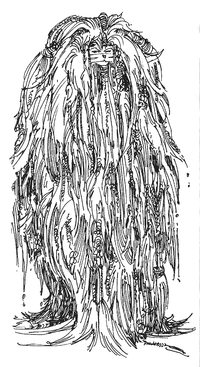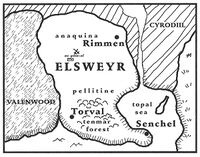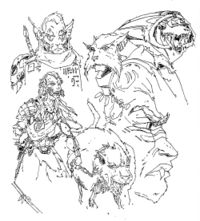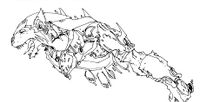Lore:Pocket Guide to the Empire, 1st Edition/The Elsweyr Confederacy
The UESPWiki – Your source for The Elder Scrolls since 1995
| ELSEWEYR CONFEDERACY |

The current Mane of Elsweyr, Nhad-hatta, wearing the braids and hair-locks of his entire tribe—Second Seed 18
- Elsweyr is the youngest of the modern regions, and the only one to have established itself in the Common Era, nearly six hundred years ago. It is inhabited by a strange race of intelligent beastmen, who call themselves the khajiit in their native tongue. These khajiit are all feline in aspect, some far more than others. A particular family-tribe, or pride, might include a hunting party of males that appear like upright jaguars, a few beautiful youths who could pass for Elves were it not for their swishing tails, an uncle or two that would stalk the perimeters on all fours, and a chief who, depending on the moons of his birth, might have the form of any of the above. The khajiit attribute their improbable biology to the workings of the ja-Kha'jay (the "Moonstrings," or "Lunar Lattice"), a magical and semi-divine phenomena believed to derive from the influence of Tamriel's twin moons, Masser and Secunda. According to the native tradition, a khajiit born while Masser is full and Secunda a thin crescent will grow to be a cathay-raht, one of the aforementioned jaguar-men, while one born under the opposite conditions will be little more than an intelligent house-cat. Even the Senche-tiger, the largest great cat in existence, has proven to be just another form of the khajiit; these massive beasts can often be found serving as steeds for their more humanoid cousins. Over twenty forms have been documented among the catmen of Elsweyr, and, in their own society at least, no one of them is more important or inherently better than another (with the exception of the Mane form, to be described shortly). However, the ohmes, or "man-faced" khajiit, are those most commonly seen outside of the province, as most adventurers and diplomats come from this, the most discreet of the "breeds."
- Until relatively recently, the nearly constant insurrection and tribal warfare among the catmen rarely troubled the stage of history. In CE309, however, Keirgo of Anequina and Eshita of Pellitine combined their long-feuding kingdoms to create Elsweyr, sparking a great class struggle that briefly threatened to draw in outside intervention. Power shifted from two separate kingdoms, each with its own central government and allied tribes, to a nobility besieged by those tribes, who felt that both their ruling classes had betrayed them. Chieftains forgot their ancient sugar-vendettas and signed treaties of their own (recorded, incidentally, through facial tattoos), and before long the cities of former Anequina were under constant attack. Keirgo petitioned the Empire for help, but it had just lost its own ruler, Potentate Versidue-Shaie, and was in similar disarray. When the old capital, Ne Quin-al, fell to the rebels, it seemed Elsweyr would soon burst under the weight of its own union. Peace was restored, however when the normally nonpartisan khajiit spiritual leader, the Mane Rid-T'har-ri'Datta, "bestowed to the classes equality under the bi-lunar shadow, dividing their power in accordance with two-moons-dance of the ja-K'hanay". What this established, in a more understandable sense, was a rotational power base in which both sides of khajiit society, the city-dwellers under the nobility and the nomadic tribes of the desert chieftains, shared alternate control of the region based on the phases of Masser and Secunda; the terms of this measure, the Riddle-T'har, were overseen by the thinly-veiled dictatorship of the Mane himself. Since then, Elsweyr has withdrew itself into a secrecy that has scarcely been breached in five hundred years.
- Geographically, Elsweyr is a harsh area of badlands and dry plains. Only near the southern reaches does the soil turn fertile, and the whole of this region is covered in jungle and rainforests, with sugarcane groves clustering against the two main river basins. The old kingdom of Anequina is its northern section, and has historically offered no threat to either the early Cyro-Nords or the later Cyrodiliic [sic] Empires. Indeed, Pelinal Whitestrake, Nibenay warlord of the Elven Pogrom, mistook the khajiit for another strain of Aldmeri and killed many of their number before realizing his error.[YR 1]
- Understandably, the ja-Kha'jay makes the culture of Elsweyr very strange and alien. It is a peculiar affliction, which seems, at first glance, to be related to lycanthropy. It is not, however, contagious or temporal in effect like the latter- a khajiit retains the form of his birth throughout his lifespan, and the moons, while they determine that form, do not affect it thereafter. There are no known shapeshifting khajiit. On the whole, the catmen of Elsweyr are a bestial lot, victims of their own preternatural anatomies. They are quick to anger, unpredictable, and dangerous, though singly no match for an Imperial legionnaire. It is also worthwhile to point out that the so-called "human" features found among many of the khajiits are, in fact, distinctly Elven in appearance, no doubt proving once and for all the baser predilections of the Elder Race.
- This is not to say that Elsweyr is without some semblance of civilization.[YR 2] The khajiit that do walk erect dress and conduct themselves in a close approximation of a modern, human culture. Their dress is an abundant shawl, commonly of brightly patterned cloth, for defense against the harsh sun and saber-cuts. Their chief attire, the budi, or shirt, is fastened in braids down the right side, not permitting any part of the torso fur to be seen, for such is believed to be highly indecorous. Jewelry and trinkets often adorn the costume, and tattoos are very popular. In some quarters, the latter can even have religious and legal significance. A recent trend among the younger ohmes is the application of feline facial tattoos that make them resemble their more hideous and savage brethren. The obvious weapon of choice among the khajiit are their claws, naturally sharp and retractable. Others, though, have mastered the use of the saber and scimitar, the dagger and the longbow. There is no standing army in Elsweyr, and the catmen have never shown an expansionist inclination. In fact, they have lost territory in the last fifty years with the secession of their rim territories (see Rimmen).
- Tamriel's two moons are inextricably linked to the society of the khajiit, who worship their different phases, and the combination of the phases, as if they were gods. Therefore, each "breed" of khajiit has its own patron deity. Earlier it was believed this practice was just another heathen system of worship common among the beastmen of Tamriel, but recent studies in comparative religion have proven that the lunar gods of Elsweyr are merely the divinities of the Imperial Pantheon (Stendarr, Mara, Kynareth, etc.) in disguise. Similar findings have revealed that the dro-m'Athra, or dark spirits of Elsweyr, which correspond to the inverse phases of Masser and Secunda, to be aspects of the more universal Daedric powers. The khajiit also believe that their gods regularly bestow blessings to their chosen people, in the form of the moon-sugar, a substance native to the Tenmar Forest in southern Elsweyr. This sugar has a variety of uses; it is alternately a seasoning and a magical ingredient, a source of communion with the holy moons and a dangerous and addictive drug. The khajiit understand it to be "crystallized moonlight," caught in the water of the Topal Sea and brought to the sugarcane groves of the Tenmar by the force of the twin tides. By partaking of the sugar, the khajiit believes they are consuming small portions of their gods' eternal souls. This drives them into fits of ecstasy and abandon, and the streets of Elsweyr's major cities are full of catmen shivering in the grip of sugar fits. A particularly hazardous derivative of the moon-sugar, known as skooma, is often smoked in raw form through a water-pipe by the more pathetic khajiit; its victims are addicted for life, and in constant, alternating states of euphoria and lethargy. Nevertheless, moon-sugar is a daily part of khajiit life, and their kingdom's chief export. The food of Elsweyr is invariably sweet; candies, cakes, puddings, and sugarmeats are the staples of the khajiit diet, and travelers to Elsweyr are cautioned against partaking of any of the native food. Humans, it seems, are even more susceptible to the effects of the moon-sugar than the catmen themselves.
|
Places of Note:
- Senchal
- This infamous city is the largest port in southern Tamriel. Its sprawl covers the easternmost tip of Elsweyr's Quin'rawl peninsula, a motley assortment of bazaars, taverns, merchant quarters, and open-air markets ringed on three sides by its crowded harbors. Senchal is a favorite stopping point for pirates and sea captains seeking to ply illegal or blackmarket goods, it being far easier to smuggle these goods into and out of the Empire by way of the Topal Sea than to use the well-guarded inland highways. Thieves abound here, as do beggars and pathetic khajiit sugar junkies. The traveler is advised to steer clear of Black Keirgo, Senchal's most squalid and dangerous quarter, when visiting the city. Illicit sugar-dens line the streets here, where beastmen and nobility alike wither away in sucrose fevers. All in all, Senchal is the ugliest city outside of Imperial jurisdiction. The air is humid and full of the chimney-smoke caught in the eddies from the surrounding coasts. Much of the city is abandoned or in ruins. In CE560, a strain of the Knahaten Flu blew across the channel from nearby Argonia and quickly infected the city's population. Whole neighborhoods were razed in some mad effort to cleanse Senchal of the Flu and have never been rebuilt. Visitors to the open-air markets can see these charred skylines on the periphery, as black and jagged as the teeth of the nearest sugar junkie, begging for cake.
- Torval
- Torval is the city-state of Elsweyr's spiritual and temporal ruler, the Mane. He and his tribe live here in stately and exotic palaces built from massive timbers of Valenwood oak, whose territorial borders are only a few hundred miles away. Symmetrical sugarcane gardens surround these palaces, where the Mane is often seen in day-long meditations atop his palanquin, held up by his inexhaustible cathay-raht servants. As has been said, the moon-sugar of Elsweyr is the holiest of substances to the khajiit. They speak of sugar as we might speak of the soul or the lifeforce. Therefore, humans have been traditionally forbidden to trespass on these estates, and the Warrior Guard enforce this measure as strictly as they do around the Tenmar Forest. An Imperial diplomat was not long ago chased from the premises, even though he had been promised an audience with the khajiit ruler. The panther-like Warrior Guard hissed at his approach, bared their fangs, and threatened him to leave quickly, lest they "leak his sugar" into the sand. Our Glorious Emperor, Tiber Septim, has yet to seek redress from the lawless catmen.
- Rimmen
- Though ostensibly its own kingdom, Rimmen still pays tribute to the Mane of Elsweyr, from whose realm it seceded in CE812 during the Interregnum. Earlier, Akaviri refugees had fled persecution when the warlord Attrebus briefly aspired to the Imperial Throne. Attrebus, though he lasted no longer than most of the pretender kings of that period, thought he might rid Cyrodiil of the foreigners who had ruled it for the first half of the Common Era, and he drove the Akaviris past the Empire's borders into Elsweyr. The khajiit granted them asylum in the hills and steppes of northwestern Elsweyr, where they dwelt in relative seclusion until remnants of the Dir-Kamal resurfaced in Cyrodiil, seizing the Throne from Attrebus' successors. The Rimmen (literally, the "Rim Men," as the khajiit called them) joined their brothers to try to rebuild the Empire. This effort was doomed to failure, but not before the khajiit attempted to reclaim their lands in a series of bloody border wars. Currently, since the ascension of Tiber Septim, the hapless Rimmen have once again submitted to the protection of the Mane, with a renewed tribute paying for the Cat Lord's guarantee of their independence, a truly weak reed upon which to lean.
- Annotations left by "¥R", an elven traveler sending this pamphlet to his uncle, are as follows:
- These comments only appear in a pre-release version of the text provided to The Imperial Library:


